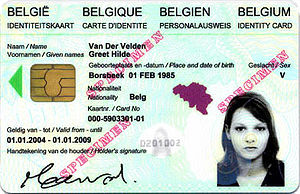
Electronic identity card
Encyclopedia

Belgium
Belgium , officially the Kingdom of Belgium, is a federal state in Western Europe. It is a founding member of the European Union and hosts the EU's headquarters, and those of several other major international organisations such as NATO.Belgium is also a member of, or affiliated to, many...
, Italy
Italy
Italy , officially the Italian Republic languages]] under the European Charter for Regional or Minority Languages. In each of these, Italy's official name is as follows:;;;;;;;;), is a unitary parliamentary republic in South-Central Europe. To the north it borders France, Switzerland, Austria and...
as well as other countries are currently issuing EICs which will replace conventional identity cards in most European countries in the future. Apart from online authentication many EICs also give users the option to sign electronic documents with a digital signature.
The EIC has the format of a regular bankcard, with printed identity information on the surface (such as personal details and a photograph) as well as an embedded microchip.
Chip contents
The eID card contains a chip containing:- the same information as legible on the card
- the address of the card holder
- the identity - and signature keys and certificates
Using the eID
At home, the user can use his eID to log in to specific websites (such as Tax-on-Web, allowing them to fill in their tax form online). To do this the user needs- his eID card
- a smartcard reader
- the eID middleware software
When other software (such as an Internet Browser) attempts to read the eID, the user is asked for confirmation for this action, and potentially even for their PIN
Personal identification number
A personal identification number is a secret numeric password shared between a user and a system that can be used to authenticate the user to the system. Typically, the user is required to provide a non-confidential user identifier or token and a confidential PIN to gain access to the system...
.
Other applications include signing emails with the user's eID certificate private key. Giving the public key to your recipient allows them to verify your identity.
Kids ID
Although legally Belgian citizens only have to carry an ID from the age of 12, as of March 2009, a "Kids ID" has been introduced for children below this age, on a strictly voluntary basis. This ID, among containing the usual things, also holds a contact number that people, or the child itself, can call when they for example are in danger or had an accident. The card can be used for electronic identification after the age of six, and it does not contain a signing certificate as minors cannot sign a legally binding document. An important goal of the Kids-ID card is to allow children to join "youth-only" chatsites, using their eID to gain entrance. These sites would essentially block any users above a certain age from gaining access to the chat sessions, effectively blocking out potential pedophiles.Italy
The Italian electronic identity card (Carta d'Identità Elettronica in ItalianItalian language
Italian is a Romance language spoken mainly in Europe: Italy, Switzerland, San Marino, Vatican City, by minorities in Malta, Monaco, Croatia, Slovenia, France, Libya, Eritrea, and Somalia, and by immigrant communities in the Americas and Australia...
, in Italy identified with the acronym CIE), is a personal identification document
Identity document
An identity document is any document which may be used to verify aspects of a person's personal identity. If issued in the form of a small, mostly standard-sized card, it is usually called an identity card...
that is replacing the paper-based ID card in Italy. The first Italian electronic ID cards (EIC) were issued in 2001. As of 1 January 2006 the Italian government requires that paper based ID cards are replaced by EICs. By the end of 2009 1.8 million Italian citizens had obtained EICs.
According to provisions of the Italian constitution only the Italian municipalities can supply identity cards to citizens. Therefore the EIC issuing system is distributed among the municipalities allowing each of them to give the EICs directly to their citizens. The Ministry of Internal Affairs supplies the required network infrastructure, software updates and security architecture. As a consequence the required issuing system is more complex than centralized ones used by other countries or for other electronic cards. Recently many municipalities joined the EIC system and currently about 180 municipalities are equipped to issue EICs. The system allows smaller municipalities to collaborate with nearby larger ones in order to reduce printing cost. The potential user base is estimated at about 50 million.
The Italian EIC is intended for both online and offline identification. Therefore, apart from the printed information, data for identification are stored on a microchip as well as a laser band. Specifically, the microchip contains a digital certificate for online authentication and (optionally) a certificate for digital signatures. The Italian EIC is explicitly designed to give access to e-government services and will become the standard for access to online services offered to Italian citizens by public authorities. The technical specifications for the Italian identity card have been developed by the Italian Ministry of Internal Affairs in collaboration with the University of Rome, Tor Vergata. The most recent legal document regarding Italian EIC standards and requirements is the Decreto Ministeriale n. 229 del 8-11-2007.
Germany
The German Identity Card is also an electronic identity card since 2010.Belgium
European Union
- Privacy Features of European eID Card Specifications a 2009 report
Germany
- Personalausweis portal, the German implementation.
- security issue with the eID cards explained by the CCC.
- Technical Guidelines (in German) with pointers to English specification at the end.

